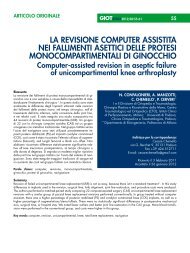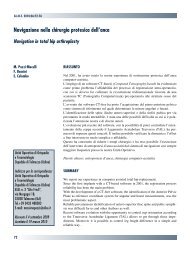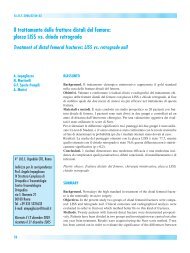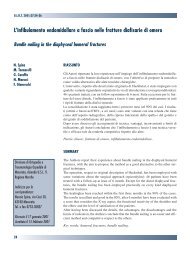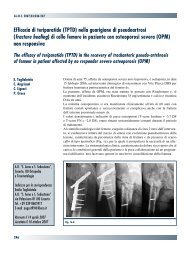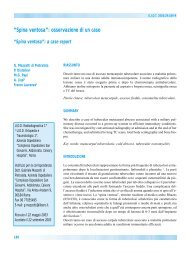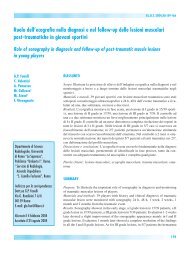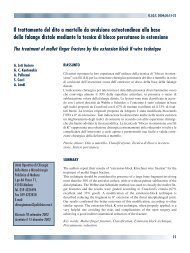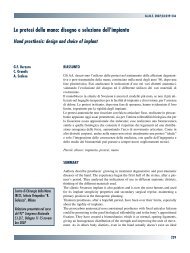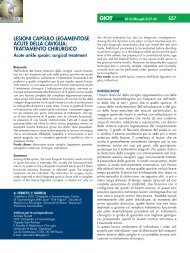Vol.XXXVII, Suppl. 1 - Giornale Italiano di Ortopedia e Traumatologia
Vol.XXXVII, Suppl. 1 - Giornale Italiano di Ortopedia e Traumatologia
Vol.XXXVII, Suppl. 1 - Giornale Italiano di Ortopedia e Traumatologia
Create successful ePaper yourself
Turn your PDF publications into a flip-book with our unique Google optimized e-Paper software.
s106<br />
agosto2011;37(suppl.1):106-108<br />
riVEstiMEnto in titanio<br />
saBBiato<br />
titanium surface implant treated by sand<br />
blasting<br />
riassunto<br />
Il grado <strong>di</strong> resistenza alle forze <strong>di</strong> taglio con impianti osteointegrati<br />
in titanio <strong>di</strong>pende dalla reazione biologica che si ha<br />
all’interfaccia. La sabbiatura della superficie del titanio migliora<br />
le caratteristiche biomeccaniche dell’impianto.<br />
La stabilità primaria risulta migliorata in impianti a superficie<br />
sabbiata, fatto, questo, che contribuisce ad accelerare la velocità<br />
<strong>di</strong> contatto con l’osso. L’aumento <strong>di</strong> resistenza alle forze<br />
interfaciali sembra essere legato all’aumento della superficie<br />
<strong>di</strong>sponibile per il contatto osseo, che è funzione del grado <strong>di</strong> rugosità<br />
superficiale. Un secondo fattore cruciale nel rapporto tra<br />
impianti con superfici rugose e tessuti biologici sembra essere<br />
legato al particolare trofismo che certe cellule, quali macrofagi,<br />
cellule epiteliali ed osteoblasti mostrano nei confronti <strong>di</strong> certe<br />
superfici rugose.<br />
parola chiave: titanio sabbiato<br />
summary<br />
The degree of resistance to shear forces with titanium osseointegrated<br />
implants depends on the biological reaction that occurs<br />
at the interface. The blasting of the surface of titanium improves<br />
the biomechanical characteristics of the system.<br />
The primary stability is improved in systems with sandblasted<br />
surface, a claim, which helps to accelerate the rate of bone<br />
contact. The increase in resistance to forces Interfacial seems<br />
to be related to the increase of available surface area for bone<br />
contact, which is a function of the degree of surface roughness.<br />
A second crucial factor in the relationship between plants with<br />
rough surfaces and biological tissues appears to be related to the<br />
particular tropism that certain cells such as macrophages, epithelial<br />
cells and osteoblasts show towards certain rough surfaces.<br />
Key words: SLA-treated titanium<br />
introduZionE<br />
Un biomateriale per poter essere impiantato nell’essere<br />
umano deve <strong>di</strong>mostrare un buona biocompatibilità e una<br />
V. ZottoLa, M. MarchEsE, c. BonELLi<br />
U.O. <strong>di</strong> Ortope<strong>di</strong>a e traumatologia, Dipartimento<br />
<strong>di</strong> Chirurgia, Azienda Ospedaliera “S. Anna”, Como<br />
In<strong>di</strong>rizzo per la corrispondenza:<br />
Massimiliano Marchese<br />
U.O. <strong>di</strong> Ortope<strong>di</strong>a e <strong>Traumatologia</strong>,<br />
Azienda Ospedaliera “S. Anna”<br />
Via Ravona 1, 22020 San Fermo della Battaglia (Como)<br />
Tel. +39 031 5859629<br />
E-mail: drmarmas@yahoo.it<br />
lunga durata (più <strong>di</strong> 20 anni) senza corrosione, fratture<br />
o delaminazioni. Sono richieste elevate proprietà meccaniche,<br />
per lo più elevata resistenza alla fatica e all’usura,<br />
inoltre è necessario che l’impianto abbia una stabilità<br />
meccanica eccellente dal momento che la fissazione al<br />
tessuto biologico con le sole interazioni chimiche è troppo<br />
debole. Per queste ragioni, è andato aumentando l’interesse<br />
per l’influenza della rugosità superficiale sulle interazioni<br />
biologiche ed è stato oggetto <strong>di</strong> molti stu<strong>di</strong>.<br />
Sono state in<strong>di</strong>viduate ed utilizzate <strong>di</strong>verse tecniche per i<br />
trattamenti superficiali e per i rivestimenti al fine <strong>di</strong> fornire<br />
una rugosità micrometrica della <strong>di</strong>mensione delle cellule<br />
ossee, per garantire la migliore osteointegrazione, ancoraggio<br />
e stabilità dell’impianto. In questo senso, i migliori<br />
can<strong>di</strong>dati per essere utilizzati come biomateriali sono il<br />
titanio e le sue leghe, trattati in superficie con ceramica<br />
o altri metalli.<br />
Tra le caratteristiche meccaniche del titanio si ricordano:<br />
l’ottima resistenza a trazione, l’ottimo rapporto resistenza/peso,<br />
la buona resistenza a fatica, l’allungamento<br />
sufficiente, la scarsa duttilità, il modulo <strong>di</strong> elasticità non<br />
molto elevato.<br />
Fra tutte le tipologie <strong>di</strong> titanio presenti sul mercato quelle<br />
che hanno le caratteristiche ottimali per la produzione <strong>di</strong><br />
protesi e <strong>di</strong> conseguenza le più utilizzate sono il titanio<br />
non legato (Ti), il titanio legato al vana<strong>di</strong>o (Ti6Al4V) ed il<br />
titanio legato al niobio (Ti6Al7Nb).<br />
Il loro comportamento nei confronti della sabbiatura superficiale<br />
è similare anche se per onestà il titanio puro è<br />
più “malleabile” e quin<strong>di</strong> a parità <strong>di</strong> “parametri <strong>di</strong> processo”<br />
<strong>di</strong> sabbiatura risulta con una rugosità più elevata.<br />
Non è possibile comunque <strong>di</strong>stinguere le leghe sopra citate<br />
solo con una ispezione visiva sia prima che dopo la<br />
sabbiatura.<br />
Il processo <strong>di</strong> sabbiatura del titanio avviene attraverso<br />
una macchina sabbiatrice ad aria compressa che produce<br />
un getto <strong>di</strong> materiale granulare utilizzando l’energia<br />
dell’aria compressa. L’abrasivo, cioè il materiale utilizzato<br />
per la “sabbiatura” del titanio delle protesi non è la<br />
normale sabbia ma è ceramica comunemente denominata<br />
corindone ovvero ossido <strong>di</strong> allumina in forma <strong>di</strong> granuli<br />
<strong>di</strong> varie <strong>di</strong>mensioni (granulometrie). Il corindone, Al2O3,<br />
è l’unica fase rinvenuta in natura per questo composto,<br />
che fa parte della classe degli ossi<strong>di</strong> con un rapporto tra<br />
metallo e ossigeno <strong>di</strong> 2:3.<br />
Il corindone utilizzato per la sabbiatura delle superfici delle<br />
protesi è ad altissima purezza, 99,99% pura alumina,<br />
e non contiene inquinanti tipo ferro e metalli pesanti che<br />
potrebbero rimanere depositati sulla superficie della protesi<br />
e dare effetti negativi dopo l’impianto.<br />
Le principali caratteristiche del corindone che ne rendono<br />
l’abrasivo ideale per il processo <strong>di</strong> sabbiatura del titanio<br />
sono la resistenza all’usura ed all’impatto, la superficie



